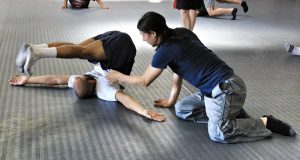Efficiency in movement has been a buzzword in the martial art world for a long time, but recently has fallen by the way side as many instructors look toward teaching something more easily explainable.
For example, efficiency in movement is not as easy to discuss as joint mobility. The concepts behind the two are similar…each has to do with being able to physically act without physical pain. But, joint mobility is something much easier to diagnose through a process of seeing what level of flexibility a student has…versus ‘do you movement efficiently?’ Weight lifters are all too familiar with the concept of efficient movement. They must executive each segment of their lift with breathing, structural alignment, muscular timing in mind. But, for someone who is teaching general concepts, going this indepth into movement and teaching efficiency with students who may have a short attention span, or who have arrived at class expecting a workout or technique training session…the teacher can quickly become overwhelmed with the individual need of students.
Instead, we should look more at teaching movement efficiency in a more palatable way – everyday living.
Everyone can easily identify with daily movements which cause them pain or discomfort which can benefit from movement efficiency. In Pramek, we like to break down daily living into core movement patterns, and then focus on the efficiency within each. We call them ‘The 5 movements’. These are movements that require skill sets no different than a weight lifter cleaning and snatching a heavy weight – except our heavy weight is that of long term ‘wear and tear’ on the body that leads to a permanent state of discomfort and compensation in the body.
The 5 movements are
- Standing up
- Bending over – knees swing froward
- Squatting
- Lifting
- Getting on the ground
Let’s break each down to what they are, and the question we can ask to see if a student is moving efficiently:
- Standing up – How does the student stand upright? Do their shoulder droop, or do they hold their shoulders back? Is their chest upright, lending toward unhibited breathing? Is their hip posture comfortable, with a stable base for their feet leading to maintaining equilibrium?
- Bending over – Does a student bend at the lumbar, or do their knees swing forward and lead to a squat? Do they suffer from lumbar or knee pain when bending over? Is their neck supported by muscles, or fall limp?
- Squatting – How does a student change planes in the transverse? Do they allow their natural movement to flow, with the hips guiding the thighs and knees, or do their knees bear the weight of the body? Does the student sit using support, plop into a seat, or do they have a controlled movement to sit?
- Lifting – How does a student gain mechanical advantage on the item? An item does not move, it is moved by the student. Does the student use only their upper body strength, or do they tie their lower body to the upper body?
- Getting on the ground -How does a student transition to the ground? Do they control their movement, using their arms as a base as they move to the ground, do they use their legs for control, or do they struggle to transition to the ground?
A teacher must constantly ask a student striving for movement efficiency, ‘Can you do what you are doing when you are 80?’
Pain and discomfort, followed by compensation in the body perhaps due to prolonged discomfort, pain, or old injury are all key indicators in each of The 5 Movements. Using products like The Helix & The Gear as a guide, a student can begin to realize efficiency in each of The 5 Movements. By pointing out the daily importance of movement efficiency in reducing pain and discomfort, combined with a standard of movement like The Helix & The Gear a student can begin to make a conscious effort whenever they perform one of The 5 in order to begin to move more efficiently.
Conscious reinforcement of correcting identifiable actions, through repetition, can create a habit of efficiency.
In the end, as we age, we must ask if we are efficient, painless, and free to utilize our degrees of movement…when we ask this question, and train to prevent it, we find the keys to movement efficiency.

